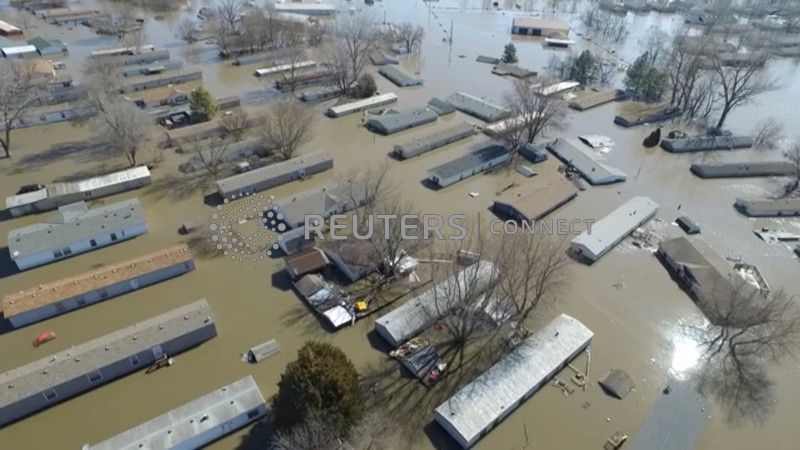KANSAS CITY, Mo. (Reuters) – Frigid floodwaters pushing down the Missouri River left ruins, death and drowned livestock in their wake across the U.S. Midwest’s farmland, and were expected to crest in northwest Missouri early Friday, with more cities and towns under threat.
Voluntary evacuations were advised in the small riverfront city of St. Joseph, Mo., where the nation’s longest river is expected to crest about 6 a.m. local time.
Debris-laden river water is expected to rise by between 29 and 31 feet (8.8 and 9.4 metres), just two feet below the height of protective levees, officials said, as the waters then head toward Kansas City about 55 miles (88 km) south and more population centers in Kansas and Missouri downstream.
“This is serious, water could easily breach those levees,” David Roth of the National Weather Service’s Weather Prediction Center in College Park Maryland.
The estimated crest height could quickly change just from a few degree differences in snow melt up stream, he said. The river could top levees or breach weak spots, he said.
“Just an unexpected precipitation could fall upstream or temperatures spike up,” he said.
Midwest daytime temperatures are already about 10-degrees Fahrenheit above normal, he said and will hit as high as 60 in parts of the Midwest Friday, including St. Joseph and Kansas City.
Flooding of the Missouri River was triggered by last week’s so-called “bomb cyclone” storm that has already inflicted damage estimated at nearly $1.5 billion in Nebraska, killed at least four people in Nebraska and Iowa and left a man missing below Nebraska’s collapsed Spencer Dam.
“This is shaping up to be a potentially unprecedented flood season, with more than 200 million people at risk,” said Ed Clark, director of the National Oceanic and Atmospheric Administration’s National Water Center in Tuscaloosa, Alabama, in the agency’s spring outlook.
Missouri Governor Mike Parson declared a state of emergency for his state Wednesday as high water forced evacuations of several small farm communities.
The declaration allows state resources and assistance to be provided directly to counties and municipalities in need.
U.S. President Donald Trump on Thursday approved a disaster declaration for Nebraska, making federal funding available in nine counties there that bore the brunt of last week’s floods.
The threat of extensive flooding lingers over the wider region and could grow dire in coming weeks with additional rainfall and melting snow runoff, National Oceanic and Atmospheric Administration officials said on Thursday.





